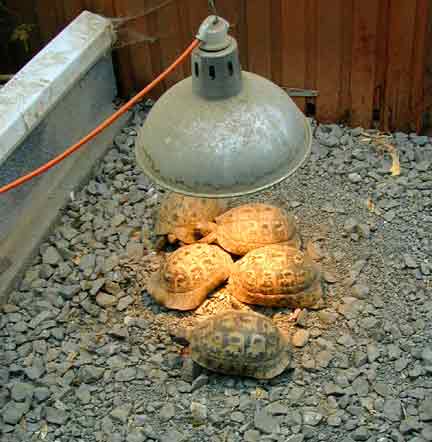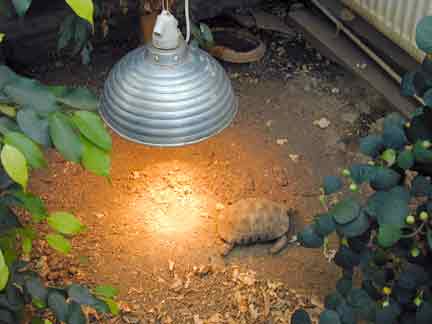
![]() WAKING UP FROM
HIBERNATION: ESSENTIAL STEPS FOR KEEPERS
WAKING UP FROM
HIBERNATION: ESSENTIAL STEPS FOR KEEPERS
A.C.Highfield

A suitable basking lamp set-up for tortoises just out of hibernation
Tortoises only enter or remain in a biological state of hibernation (which is characterised by a depressed metabolic rate) while temperatures are within a certain range. The optimum range for the hibernation of terrestrial tortoises is in the range 4-6 degrees Celsius), and for aquatic turtles is in the range 2-4 degrees Celsius. As temperatures rise towards 10 degrees Celsius, the animal’s metabolic rate begins to return to normal, and the biological state of hibernation comes to an end.
As the average mean ambient temperature begins to approach the critical 10 degrees C or 50 degrees F point, a tortoise’s metabolism will begin to reactivate in readiness for waking. Certain complex chemical and biological processes are initiated as the animal prepares to emerge into the spring sunshine. At this point, unfortunately, it often runs into its first problem. In Northern Europe, springs can be cold, wet, and miserable.
For us, this sort of weather may be merely unpleasant. For tortoises it can present rather more serious problems. Upon first emerging from hibernation a tortoise is depleted in strength, has a low White Blood Cell (WBC) count, and is very vulnerable to infection. Unless it receives adequate quantities of heat and light it will simply ‘not get going properly’, and instead of starting to regain weight and strength lost during hibernation, will refuse to eat, will use up its existing fat and energy reserves, and will begin to decline.
- If the tortoise wakes up,
and temperatures are approaching or above 10 Celsius
or 50 degrees F monitor carefully. If such
temperatures are sustained it will begin to use up
vital resources. While short periods above these
temperatures can be tolerated, EXTENDED PERIODS can be
dangerous, In such cases it is safer to get the
tortoise up and actively feeding again with the
assistance of artificial light and heat.
- Also, if you detect that the tortoise has urinated in the hibernating box, get it up and keep it awake too.
- As the temperature rises
listen carefully to the hibernating box - you should
begin to hear the first sounds of movement.
Remove the hibernating box from its winter quarters and warm it up by placing it close to a heater. After an hour or so remove the tortoise from its box and place it in a warm, bright environment. A 150 Watt reflector lamp suspended about 40cm (15”) above the tortoise will make a huge difference. Do not expect a tortoise to begin feeding without this sort of artificial assistance in the U.K. – British spring weather is totally different from that in the Mediterranean. Tortoises must have extra light and heat at this sensitive time. Keeping the tortoise in the house, even if well heated, is still not likely to be sufficient unless a basking lamp of this type is also provided. They need to raise their body temperature to around 30 degrees Celsius – and this is far hotter than any room comfortable for humans can sustain. A simple basking lamp can make a huge difference – use one always!

Both radiant heat and light in adequate quantity and quality are absolutely vital to get the tortoise functioning properly. We cannot stress this enough. It is not optional. It is essential! There is an excellent article on our website called “Understanding Reptile Lighting Systems”. This article explains the different types of lamp that are available, and how to install and use them to best advantage.
We receive numerous calls for help from people who tell us that their tortoise came out of hibernation “several weeks ago” but “is not eating or doing much yet”. Our first question is “Do you have it in a nice warm, bright place with a basking lamp?” The answer is almost invariably “No”. Even people who have read our advice in “Safer Hibernating and Your Tortoise” often make this mistake. Maybe they think that these basic biological rules do not apply to their particular tortoise? We don’t know. We do know, however, that every year animals die unnecessarily because this simple and low-cost step is ignored. There really is no excuse. Tortoises need light and heat. The method we describe here is the easiest and most effective way of providing it. It will cost you less than 15 GBP to provide such a facility. Consider the veterinary costs that may be incurred if you do not!
Hydration and drinking
Many people experience problems in getting tortoises to drink - in fact almost all tortoises will drink provided water is offered in a suitable manner. We recommend placing the entire tortoise in a sink or washing-up bowl filled with about 25 mm (l’’) of very slightly warm water - less in the case of very small tortoises, a little more for giant specimens. Simply offering a small dish of water to the tortoise is not likely to stimulate a good drinking response, but actually placing it in water is usually successful. Splashing water on the shell and around the head also often helps.
Drinking is, at this stage, far more important than feeding. Both dehydration and the presence in the renal system and bladder of toxins dictate that every effort must be made to encourage drinking first, feeding later. See our other website article ‘Tortoises - Do they Need to Drink’ for more on this subject.
The tortoise must also be kept warm as described previously- it is absolutely vital that such temperatures are maintained in order to speed up activation of the tortoise’s digestive system. As the tortoise awakes certain biological changes take place; one of the most important of these is the release into the bloodstream of a chemical called glycogen, which has been stored in the liver. This provides extra energy to give the tortoise an initial ‘boost’. Feeding must take place before this is exhausted, or the animal will begin to decline. The glycogen level can be artificially boosted by providing water with glucose in solution daily - about 2 teaspoons per 250 ml dilution, at about l0-20 ml per day for an average sized animal. Do not continue this therapy indefinitely, or dangerously high blood-sugar levels may be attained. Four or five days maximum should be sufficient.
All tortoises should very definitely feed within ONE WEEK of emerging from hibernation. If they do not there is either;
A health problem
A husbandry problem (usually lack of heat and light)
If your
tortoise is not feeding by itself within one week of
waking up (provided the correct conditions are present)
do not delay any longer - consult a veterinary surgeon that has
particular experience of reptile husbandry, physiology
and treatment.
Seek the underlying cause of the problem, and do not be
satisfied with non-specific ‘vitamin injection’ therapy.
There is always a logical and very good reason for a
tortoise persistently refusing to eat, and generalized
vitamin deficiencies are highly unlikely to be
responsible. Good diagnostic techniques, combined with
an understanding of reptile metabolism and function,
will invariably produce a satisfactory answer. Out of
literally thousands of tortoises we have seen over the
years with feeding problems, from ancient Galapagos
giants to tiny newly hatched babies, we have never yet seen one suffering from anything which a
general non-specific ‘vitamin injection’ would correct.
It is highly unlikely, to say the least, that yours is
the exception. Whatever you do, please do not delay. A
tortoise which refuses to feed after a week or more of
correct temperatures definitely has a veterinary
problem that requires professional investigation. Delay
in these circumstances can result in the loss of your
tortoise, as it is especially vulnerable at this time.
In most cases, however, if you provide suitable
conditions, with adequate heat and light, and ensure
adequate hydration, your tortoise will make a very fast
recovery from its winter sleep and will soon begin
feeding normally.
© A. C. Highfield 1986-2011